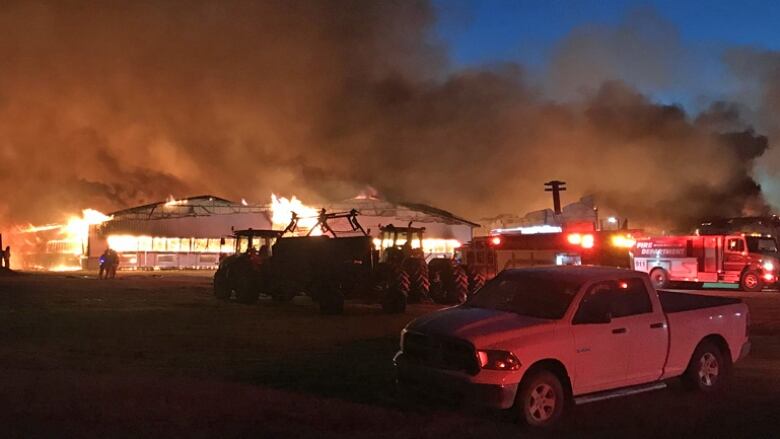'Terrible way to go': Humane society wants changes after hundreds of cows killed in blaze
Animal welfare group says barns no longer are mandated to have certain safety requirements

An animal welfare group is calling onManitoba's provincial government to review how animals are being housed, after 800 cows were killed in a barn fire northeast of Steinbach, Man.
Brittany Semeniuk, an animal welfare consultant for the Winnipeg Humane Society, spoke on CBC Radio's afternoon show Up To Speed,one day after the devastating blaze at Pennwood Dairy. She said the prevalence of such events drives home the need for changes.
"They do occur in a very high frequency and I mean I don't need to convince anyone that perishing within a fire where you're trapped in a building is a terrible way to go," Semeniuktold host Ismaila Alfa.
Pennwood Dairy was one of Manitoba's largest dairy producers. Of its 1,000 cattle, only 200 lived through the blaze, according to the Steinbach Fire Department.
Fire chief Kelvin Toews said thefire was the "probably the largest barn fire" the department has ever had to dealwith.
"We've had barn fire where we've lost one or two barns, but this is quite a sizeable loss," he said.
Manitoba previously had its own farm building code, but Semeniuk said in 2017 the general Manitoba building code replaced it.
She said the problem started with recent repeals and amendments of security and fire protection requirements in low-occupancy buildings, which are recommended in the dairyindustry, but not always practised.
"They follow the codes of practice for their own industry which is governed through the National Farm Animal Care Council, but within these codes of practice none of these codes are mandatory," she said.
Semeniuk said in the past 10 years about 40,000 hogs have bee killed in barn fires, and just a few months ago almost 27,000 chickens were burned alive.
"A thousand pigs or a thousand chickens could still be qualified as low human occupancy, despite having a large number of animals, but because barns proved to be a lower safety hazard than human health, it was generally accepted to remove a lot of those previous precautions," she said.
Semeniuk says protecting animals from fires isn't the only reason for such precautionsallowing them to enjoy a certain quality of life is also important.
"They can't perform their basic behavioural needs like foraging and flying and rooting and things like that," she said. "It is currently not required to provide dairy cows with any sort of access to the outdoors."
Simply put, Semeniuk said the humane society wants better living conditions for animals and to provide them basic welfare requirements.
Regulations for barn standards are put into place by the fire commissioner, who will routinely provide updates and necessary changes to how new barns need to be constructed, according to David Wiens, a member of the board of directors for the Dairy Farmers of Manitoba.
"As we go along, there's new regulations that come in place. New barns that are being now have fire barriers within the barn to prevent the rapid spread of the fire," he said.
Wiens isn't entirely sure of the makeup of the barn that caught fire, but said four barns were attached to one another.
The Officer of the Fire Commissioner of Manitoba said they do not keep track of livestock losses. The fire is still under investigation.
With files from Ismaila Alfa and Ramraajh Sharvendiran












_(720p).jpg)


 OFFICIAL HD MUSIC VIDEO.jpg)
.jpg)



























































































